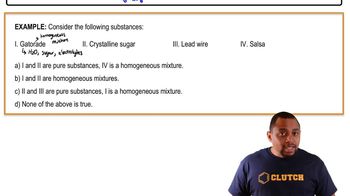Textbook Question
(a) How many significant figures should be reported for the volume of the metal bar shown here?
13
views
 Verified step by step guidance
Verified step by step guidance



(a) How many significant figures should be reported for the volume of the metal bar shown here?
Classify each of the following as a pure substance or a mixture. If a mixture, indicate whether it is homogeneous or heterogeneous: (c) aluminium
Classify each of the following as a pure substance or a mixture. If a mixture, indicate whether it is homogeneous or heterogeneous: (d) iodine tincture.
Classify each of the following as a pure substance or a mixture. If a mixture, indicate whether it is homogeneous or heterogeneous: (a) milk